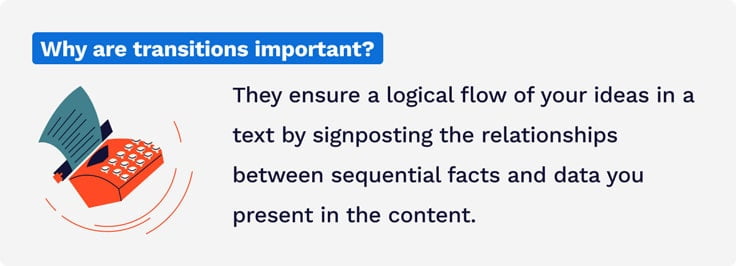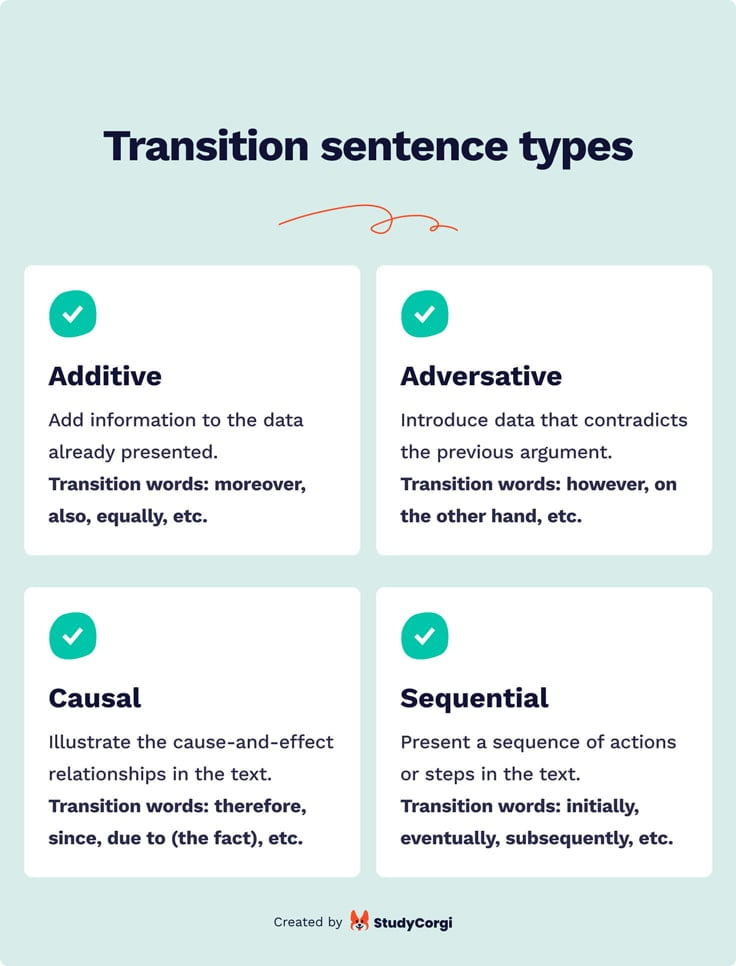📝 Transition Sentence Maker – How to Use It?
Chunky content is very hard to read, spoiling the overall impression and reducing your grades. A good way to counter this problem is to add transitions to your essay, such as starters, logical links between sections, and concluding transitions.
If you’re unsure of how to write transition sentences correctly and effectively, here is our automated and smart transition sentence maker. It can help you with any transition-related task and improve the flow of your essay for better readability and impact.
Take these steps to use the tool:
- Select what you need it to do: add transitional sentences to your text or show suitable transition phrase examples.
- Add the required information: paste your essay or select what transition phrase ideas you wish to be demonstrated.
- Push the button and enjoy the result.
👌 The Benefits of This Transition Sentence Maker
So, how can our transition sentence generator help you out?
Here are the key benefits of this creator you’re sure to enjoy:
| 🎵 Tunable | This tool is easy to customize to your writing needs; you may choose among different transition sentence types and determine their purposes. |
|---|---|
| 🔀 Flexible | The transition generator can either provide a list of examples for your inspiration or be used for the addition of transition sentences directly to the text. |
| 🦄 Intuitive | Users can follow the prompts inside the transitional sentence maker to move on with their tasks quickly. |
| 💸 Free | You don’t need to pay anything for using this transition sentence generator; no hidden fees await you on our resource. |
🎓 Transitional Sentences in Academic Writing
Transitional sentences ensure a logical flow of your ideas in a text by signposting the relationships between sequential facts and data you present in the content.
This way:
They can be seen as bridges between one fact and another or a link between the external evidence you’ve cited from a published source and your interpretation of that data.

Here is an illustration of how a transition sentence functions in the context:
Here, as you can see, the second sentence smoothens the transition from an idea about the rising magnitude of human impact on the ecology to a discussion of human efforts to offset that impact.
🤔 Where to Place Transition Sentences?
As a rule, transitions are used to signpost a movement from one idea to another one, so they are used between various parts of an academic writing piece:
| Transition paragraphs for longer texts | In larger works, where each argument is given several paragraphs or even pages, it’s reasonable to use transition paragraphs. This way, you give readers an idea that the previous argument is wrapped up, and a new idea is explored in the following lines. |
|---|---|
| Transition sentences for longer texts | Yet, if your text is not that long, and you have one idea per paragraph, a transition sentence may be the final sentence of your paragraph or the topic sentence of the next section. |
✍️ How to Make Transition Sentences?
In a nutshell, a good transition should clarify the relationship between your ideas in the text. Without transitions, any text will look chunky and abrupt, which is hard to read and make sense of.
So:
It’s impossible to dedicate a complete text to one idea only, and you need smooth transitions that guide your readers like a compass and let them trace the line of your argument consistently.
In other words:
Transition sentences make texts clear and user-friendly; you can turn any sentence into a transition unit by adding transition phrases meant for specific linking purposes.

Here are some examples for your guidance.
Additive Transition Sentence Examples
As the name suggests, additive transition sentences are needed to add information to the data bits you’ve already presented and to show that they support each other.
Here is an example of adding data in the context:
As you can see in this example, the second sentence adds some context to the discussion of first-year students and creates a logical basis for the concluding sentence.
Adversative Transition Sentence Examples
Adversative transitions are used when the author needs to introduce data that contradicts the previous argument or adds new data that illustrates the discussed object from another perspective.
Here’s how it works in context:
In this paragraph, an adversative transition sentence was used to add new data to the importance of high-quality sleep, followed by a more extended discussion of the role of nutrition and water in a person’s well-being.
Causal Transition Sentence Examples
Causal transitions are meant to illustrate the causal relationships between data in the text. They should be used carefully, as a wrong causal relationship may confuse the readers and reduce readability.
Here’s how it works:
Sequential Transition Sentence Examples
Sequential transitions are a great way to present a sequence of actions or steps in the text. They allow the readers to understand that the discussion of the previous step has ended, and the author proceeds to the next stage.
Here’s an example of this transition sentence type:
Thank you for reading this article! If you’re looking for transitional words and phrase ideas, check the tools we’ve developed:
❓ Transitional Sentence Maker FAQ
❓ What are the transition sentences?
Transition sentences are special syntactic tools that allow a writer to transition from one idea to another one and show the relationships and sequence between ideas. They function as bridges between two chunks of written content that help readers move on without abruptness.
❓ What is the purpose of a transition sentence?
They guide the readers throughout the content and communicate the author’s vision of the topic and the relatedness of discussed facts. This way, they operate as road signs of similarity, difference, sequence, or cause and effect in the relationship between several content elements.
❓ How do you write a transition sentence?
To make a sentence function as a transition from one idea to another, you need to add transition words and phrases to it, depending on the type of relationship you wish to communicate. Thus, if you move from one argument to another and need a link between paragraphs, it will be better to use concluding statements at the end of the paragraph as a wrap-up.
❓ How to write a conclusion transition sentence?
A conclusion transition sentence usually starts with a concluding transition phrase, like “to sum up the presented evidence” or “summing up,” followed by a restated thesis statement. This way, the author shows to the readers that they have started the conclusion part.